Lisianthus Flower Varieties: The Complete Growing Guide
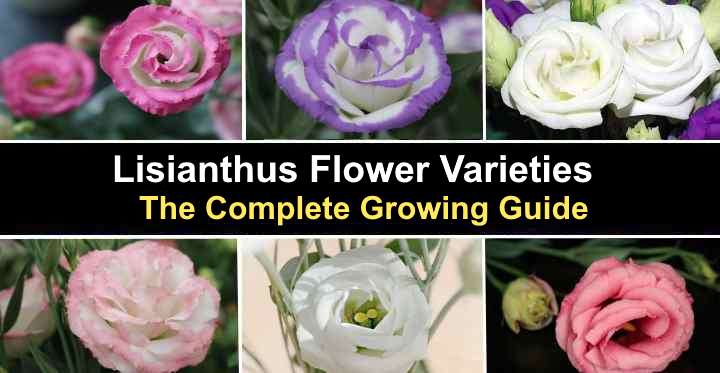
Lisianthus flowers are enchanting and delicate blooms that look like roses. The beautiful pink, purple, and white showy flowers are popular landscaping blooms for warm climates. Elegant lisianthus flowers are known for their ruffled petals and thick waxy leaves. From summer until the first frost, the beautiful flowers fill gardens with color, fragrance, and romantic beauty.
Lisianthus flowers are popular for adding vibrant colors to landscapes. The rose-like flowers also look spectacular in cut flower floral arrangements. Whether you want to plant lisianthus flowers for their elegant charm in a garden or use them for cut flowers, there are various flower colors for your requirements.
Read this gardening guide to learn more about the various lisianthus flower varieties and how to grow them. You will get tips on soil, watering, and pruning techniques to ensure healthy and abundant lisianthus blooms.
About Lisianthus (Eustoma spp.) Flowers

Lisianthus flowers belong to the genus Eustoma and flowering plant family Gentianaceae. The showy Eustoma flowers resemble roses and grow on single or branching stems 1 to 3 ft. (0.3 – 1 m) tall. The showy flowers can be single or double blooms and come in pink, purple, and white shades.
Lisianthus is often referred to as the “Texas Bluebell” or the “Prairie Gentian”. It is known for its elegant, rose-like appearance and is widely cultivated for its ornamental value in gardens and floral arrangements.
In Greek, ‘Lisianthus’ is derived from the words ‘lysis,’ meaning dissolution, and ‘anthos,’ which translates to flower. The term can be interpreted as ‘dissolving flower’ or ‘flower of dissolution.’
Lisianthus flowers grow as perennials in warm climates in full sun. In cooler climates, the tall flowers grow as annuals, or you can plant them in containers and overwinter them indoors.
Depending on the regional climate, lisianthus may start blooming in June or July and continue to adorn gardens until September or October. To promote more blossoms, deadheading is recommended.
Lisianthus flowers are typically bell-shaped, gentian-like blooms with ruffled petals. The showy, vibrantly colored flowers grow between 1” and 3” (2.5 – 7.5 cm). The flowers are mainly grown for cut flowers and long vase life which is up to three weeks.
Although lisianthus flowers are grown from seed, they are notoriously difficult to germinate. They require specific growing conditions for seedlings to grow. Lisianthus flowers take five to six months to bloom after planting. Most gardeners buy plugs or transplants to enjoy the blooms in the same season.
What are the Reasons to Plant Lisianthus
Lisianthus is a popular choice for planting due to its stunning aesthetic appeal and long-lasting blooms. With its rose-like flowers available in a variety of colors, such as white, pink, lavender, and purple, lisianthus can add an elegant touch to any garden or floral arrangement.
Its versatility allows it to thrive both indoors and outdoors, making it a suitable option for various gardening preferences. Furthermore, these flowers attract essential pollinators like bees and butterflies, contributing to a vibrant and diverse ecosystem.
Beyond its horticultural benefits, lisianthus holds symbolic significance, often representing appreciation and gratitude. In many cultures, these flowers are used in ceremonies, weddings, and other cultural celebrations to convey sentiments of acknowledgment and charisma.
Additionally, their long vase life makes them a sought-after choice for cut flower arrangements and bouquets, further adding to their allure for both personal and commercial use. Whether for garden aesthetics or cultural symbolism, planting lisianthus can bring beauty and meaning to any environment.
Lisianthus Flower Facts
Lisianthus is native to the southern United States, Mexico, northern South America, and the Caribbean. It is commonly found in warm regions and is appreciated for its attractive, showy flowers.
Here are some facts about the best growing conditions for growing lisianthus flowers:
- USDA Hardiness Zone: 8 to 10
- Sun Exposure: Full sun
- Soil Type: Slightly acidic to neutral, well-drained soil
- Watering Requirements: Keep the soil consistently moist but not soggy, allowing the top layer to dry between waterings
Lisianthus flowers are also called prairie gentian, Texas bluebell, or poor man’s rose. Varieties of the beautiful flowering lisianthus are classified into four distinct groups. Their blooming time is based on light and heat.
Here are the four lisianthus flower groups:
Group 1: Blooms in early summer in moderate light and heat. This group includes the ‘Echo’ and ‘Doublini’ series.
Group 2: Blooms in summer in high heat and light. This group includes lisianthus flowers in the ‘Excalibur,’ ‘Rosanne 2,’ ‘Voyage 2,’ and ‘Mariachi.’
Group 3: These lisianthus flowers bloom in late summer when it’s cooler but still moderate light and heat. This group includes the lisianthus series ‘Rosita 3,’ ‘Mariachi Grande,’ and ‘Voyage 3.’
Group 4: Lisianthus flowers in Group 4 are typically grown commercially for winter production in warmer climates.
Some popular varieties of lisianthus include:
Echo Series: Known for their large, double-flowered blooms in various colors such as blue, pink, and white.
ABC Series: Recognized for their uniform growth habit and range of vibrant colors including purple, blue, and white.
Mariachi Series: Noted for their unique and richly colored blooms in shades of blue, purple, and pink.
Flamenco Series: Valued for their long stems and a wide array of hues, including shades of yellow, pink, and lavender.
Lisianthus Colors
Lisianthus flowers come in a wide range of colors. These colorful blooms include soft pastel pinks, lavenders, and whites, making them perfect for romantic arrangements. Other varieties of lisianthus have vibrant purples and pinks, creating a dramatic statement in flower beds or planted along a foundation line or fence line.
Types of Lisianthus Flowers (with Pictures)
Showy lisianthus flowers can be delicate single blooms or rose-like showy double blooms. Some varieties are called ‘big bloom’ lisianthus due to the large, colorful flowers on display.
Let’s look at some of the stunning lisianthus plants you can grow to enhance your front or backyard’s aesthetics.
Lisianthus ‘Lisa Pink’
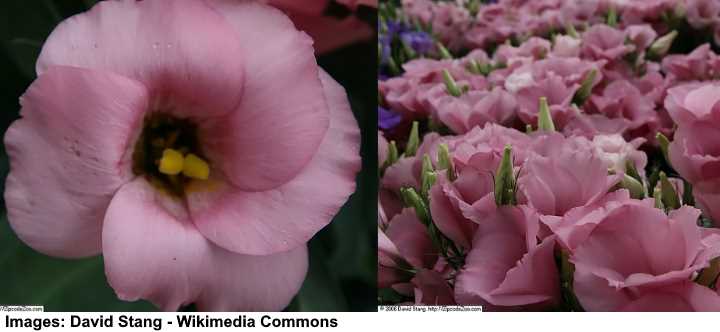
Lisianthus ‘Lisa Pink’
Lisianthus ‘Lisa Pink’ flowers are unique, showy, cup-shaped blooms in soft pink shades. The trumpet-like flowers have five ruffled petals and feature a dark throat with yellow stamens in the center. ‘Lisa Pink’ flowers are elegant and romantic—perfect for floral arrangements.
Lisianthus ‘Avila purple’
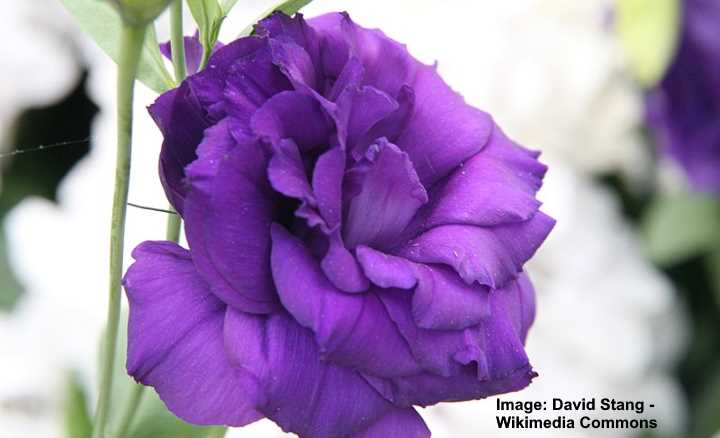
Lisianthus ‘Avila purple’
Lisianthus ‘Avila Purple’ is a striking Eustoma variety known for its deep and vibrant purple blooms. The ruffled double flowers are reminiscent of miniature roses. With long, sturdy stems, ‘Avila Purple’ is a favored choice for floral arrangements due to its excellent vase life and vibrant colors.
Lisianthus ‘Florida Silver’
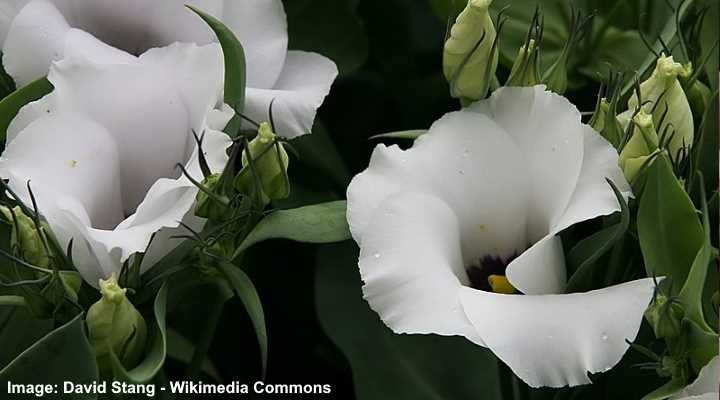
Lisianthus ‘Florida Silver’
Lisianthus ‘Florida Silver’ flowers are enchanting trumpet-shaped pristine white blooms. These white lisianthus flowers have five elegant petals with wavy margins. These bloom on tall stems, making them perfect for romantic floral displays. The pure white flowers contrast nicely with the waxy, deep green leaves on the erect, upright stems.
White Lisianthus Flowers
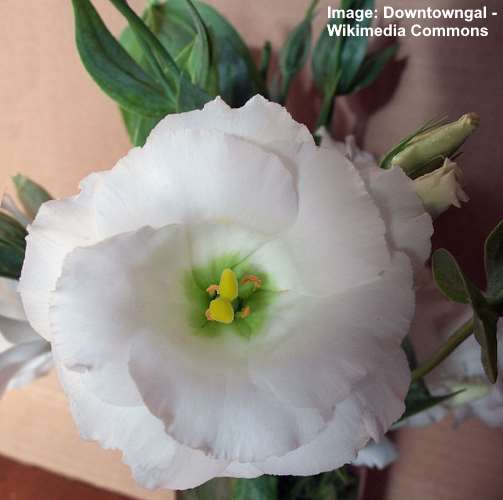
White lisianthus Flower
White lisianthus flowers are eye-catching snow-white petals in an open rosette form. Outstanding features of the rose-like flowers are the lime green center and pale green and orange and yellow stamens. The deep green, lanceolate leaves have pronounced veining, and the flower buds are pale green.
Lisianthus ‘Forever Blue’
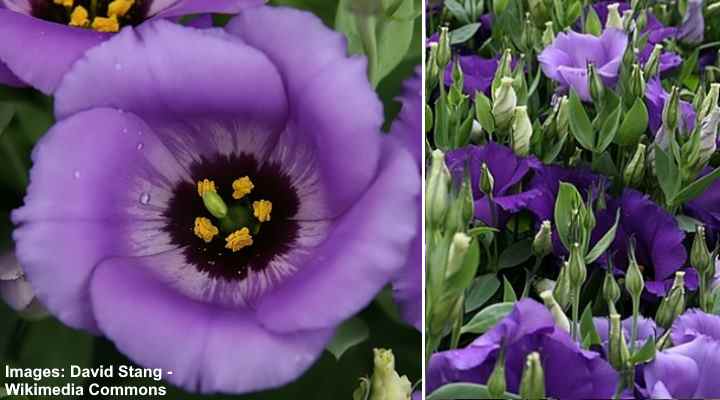
Lisianthus ‘Forever Blue’
Lisianthus ‘Forever Blue’ flowers are a purplish color with ruffled, funnel-like blooms. The large 2.5” (6 cm) single purple flowers bloom abundantly on the branching stems. These eye-catching purple flowers grow 12” (30 cm) tall, and the plant’s distinct branching habit creates a densely blooming plant.
Lisianthus ‘Forever Blue’ flowers are ideal for growing in a full-sun garden and tolerate heat. They also thrive in patio containers if you want to overwinter the beautiful flowers indoors. You can also grow the bushy lisianthus flowers in hanging baskets for a stunning visual display.
Lisianthus ‘Mariachi Lime Green’
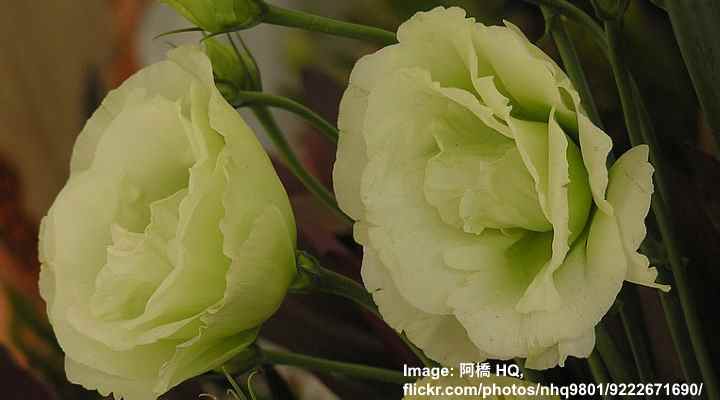
Lisianthus ‘Mariachi Lime Green’
Lisianthus ‘Mariachi Lime Green’ is an unusual lisianthus variety due to its unique lime-green blooms. The lisianthus pale green flowers have ruffled petals in a cup shape, giving the blooms an intriguing texture, form, and color. These vibrant lime-green blooms create a lively and eye-catching display in gardens and cut flower floral arrangements.
Lisianthus ‘Balboa Blue Rim’
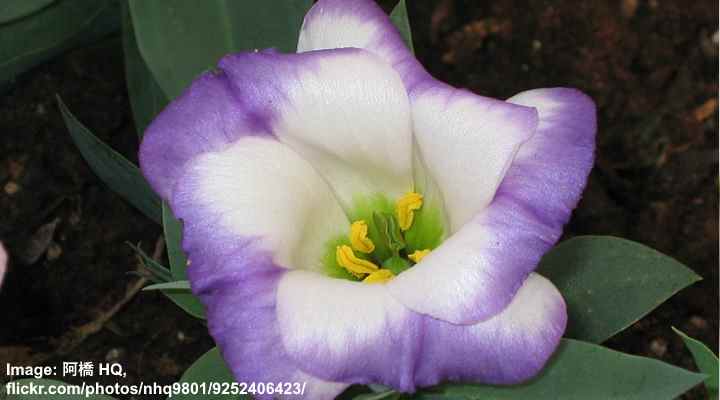
Lisianthus ‘Balboa Blue Rim’
Lisianthus ‘Balboa Blue Rim’ flowers are captivating blooms with striking white petals and purple edges. The bi-color lisianthus flowers are large, trumpet-shaped, with green throats and stumpy yellow stamens. This unique rimmed pattern makes ‘Balboa Blue Rim’ a classy lisianthus flower variety.
Lisianthus (Eustoma grandiflorum) White
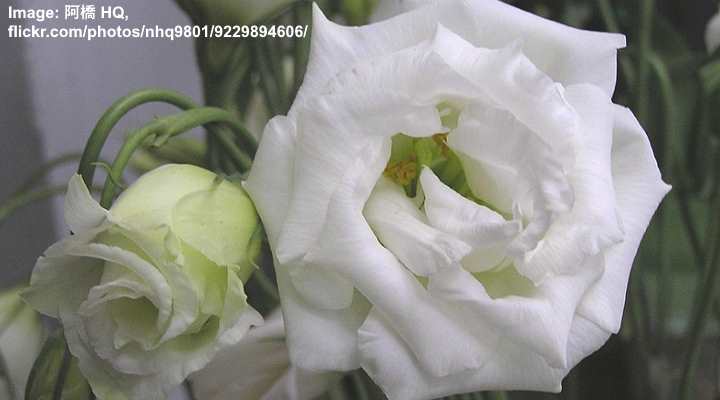
Lisianthus (Eustoma grandiflorum) White
Lisianthus grandiforum white flowers are elegant rose-like pure white blooms featuring a rosette of curled petals. The graceful double flowers bloom with two to seven flowers per stem. These stunning white flowers are a great substitute for roses, and their long vase life makes them perfect for cut flower arrangements.
Lisianthus (Eustoma grandiflorum) Purple
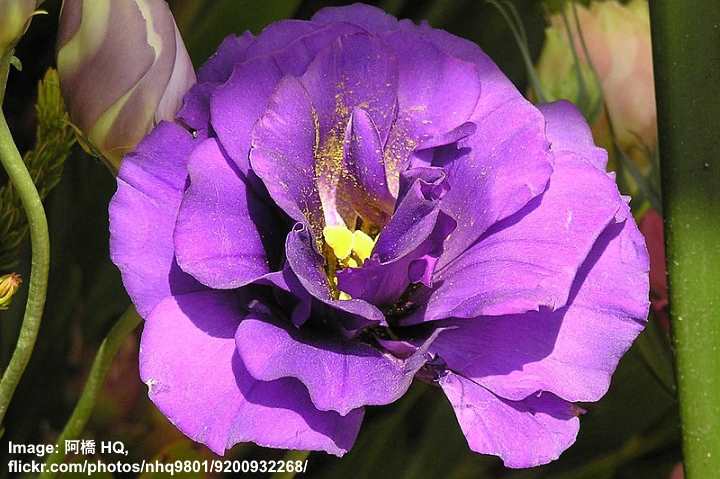
Lisianthus (Eustoma grandiflorum) Purple
Lisianthus grandiforum purple flowers are eye-catching, vibrant, rich purple blooms. These showy flowers have characteristic ruffled lisianthus petals in an open rosette form. The deep purple colors contrast nicely with the bright yellow stamens and green foliage. Purple lisianthus flowers add a touch of luxury, sophistication, and charisma to gardens and cut flower displays.
How to Grow Lisianthus
You can plant lisianthus flowers as perennials in USDA zones 8 through 10 in full sun. In other regions, the plant grows as an annual. Lisianthus flowers are tricky to grow. However, by considering the right soil, light, and watering requirements, you can enjoy these spectacular flowers in your front or backyard.
How to grow Lisianthus from Seed?
Growing lisianthus from seed is notoriously challenging. The seeds are so fine they look like dust. To grow Lisianthus from seed, you can start the seeds indoors early to mid-winter in seed trays filled with a peat-based potting medium. Keeping the temperature constant at 70 – 75°F (21 – 24°C) is vital, using grow lights to ensure 16 hours of sunlight daily or successful germination.
You can transplant the seedlings to the ground after they have developed two to three true leaves, ensuring they have sufficient space to grow to their mature height. Plant them in the sunniest part of the garden where the soil is consistently moist but never waterlogged, and ensure they receive at least 6-8 hours of sunlight daily. Regularly feed them with a balanced, water-soluble fertilizer during the growing season and provide support if the plants become top-heavy.
Throughout the growth process, be vigilant for common pests like aphids and spider mites, and promptly address any signs of infestation. Additionally, maintain good air circulation to prevent issues such as powdery mildew. With proper care and attention to their specific requirements, lisianthus seeds can develop into vibrant, long-lasting blooms, adding a touch of elegance and color to your garden or floral arrangements.
Alternatively, you can buy plugs from the garden center and plant them outdoors when the danger of frost has passed.
In warm winter climates, you can spread lisianthus seeds on the ground in late summer, and they will bloom the following spring.
Light for lisianthus plants
Lisianthus flowers thrive in full sun, requiring six to eight hours of direct sunlight daily. While they can tolerate partial shade, full sun promotes robust growth, abundant blooms, and lush foliage. Adequate sunlight is essential for developing sturdy stems and vibrant, long-lasting flowers in lisianthus plants.
Soil for lisianthus plants
Lisianthus flowers perform best in well-draining soil with slightly acidic to neutral pH levels between 6.5 and 7.0. The soil should offer good aeration and retain moisture. Amending the soil with organic matter like leaf mold or compost can improve its quality. These enrichments also help retain moisture, allow proper drainage, and provide nutrients.
Lisianthus plants cannot survive in waterlogged soil. Therefore, keeping the ground damp but not overly wet is vital.
Watering lisianthus plants
Lisianthus flowers require consistent moisture to bloom vigorously. The best watering technique is to allow the top layer of soil to dry between waterings. Then, water thoroughly, ensuring plenty of moisture reaches the roots. Drip or soaker hose irrigation is ideal for dry foliage and prevents foliar diseases.
When growing lisianthus flowers, avoiding overwatering is essential. The soggy ground can cause root rot and kill the plants.
Temperature and Humidity for Lisianthus Plants
Heat-loving lisianthus flowers thrive in warm climates in temperatures between 75°F and 85°F (24°C – 30°C). At night, a temperature range of 60°F to 65°F (15.5 – 18°C) is ideal. Once established, the beautiful flowering plants are drought-tolerant.
Lisianthus flowers don’t tolerate high humidity. Therefore, it’s vital to ensure adequate spacing between plants to provide ventilation.
Lisianthus Fertilizer
Fertilize lisianthus with a balanced, water-soluble fertilizer during the growing season every other time you water the plants. Avoid excessive nitrogen, which can lead to excessive foliage growth. Potassium-rich fertilizers like kelp meal, potash, and alfalfa help boost flower production throughout the season.
In addition to a balanced NPK fertilizer for flowering plants, it’s vital to ensure the lisianthus flowers get enough calcium. Therefore, if you notice browning leaves on your plants, check the soil for nutrient deficiency, especially calcium. You can amend the soil with a suitable calcium-nitrate fertilizer.
Lisianthus Pruning
Lisianthus flowers are typically grown for cut flower arrangements. Therefore, deadheading lisianthus is good for the plant as you can encourage it to bloom throughout the summer until fall. According to researchers at Cornell University, deadheading is better for lisianthus than pinching the flowers.
Proper pruning helps keep the lisianthus tidy and prevents the flowers from going to seed. You can cut the rose-like flowers at the bottom of the stem and place them in a vase to brighten your home.
Common Pests & Plant Diseases
Common pests affecting lisianthus flowers include aphids, fungus gnats, thrips, and whiteflies. Aphids can distort new growth, while spider mites create stippled leaves. Whiteflies excrete honeydew, leading to sooty mold. The honeydew may also attract more ants to your yard, which will then protect the pests.
The best way to get rid of pests like aphids from lisianthus is to spray the foliage and flowers with insecticidal soap or a neem oil solution. Also, avoid overwatering the flowers to prevent root rot and fungus gnats.
Lisianthus can also be prone to fungal diseases like botrytis and powdery mildew. Proper care, good air circulation, and vigilance help prevent these issues.
Common Problems With Lisianthus
A common issue with lisianthus plants is that they topple over due to weak stems or overcrowding. Also, some gardeners may find that the rose-like blooms don’t last as long in a vase as expected. Another problem is a lack of full flowering.
Here are solutions to a few problems with lisianthus plants.
Plants Topple Over
The tallest lisianthus plants grow up to 3 ft. (1 m) tall. Therefore, weak stems or overcrowding can lead to the stalks not supporting the weight of the flowers. As a solution, you can stake taller varieties or provide support. Ensure proper spacing to allow for better air circulation and stronger growth.
Cut Flowers Don’t Last
Lisianthus flowers should last up to four weeks in a vase. However, you may find that yours don’t last as long. Here are a few tips to extend vase life and enjoy the rose-like blooms for several weeks:
- Change water regularly
- Re-cut stems at an angle
- Keep the cut flowers in a cool place
- Remove any submerged leaves to prevent decay
- Add some sugar to the water to provide ‘food’ for the blooms
- Put a couple of drops of household bleach in the water to kill bacteria
Flowers Aren’t Nice Enough for Cut Arrangements
Lisianthus flowers are high-maintenance plants, and you may struggle to get blooms as attractive as those in a florist’s shop. In a garden setting, it’s challenging to mimic the carefully controlled conditions of a commercial greenhouse. Therefore, it’s best to enjoy the beautiful lisianthus flowers as they are in the landscape.
Lisianthus Flowers – Frequently Asked Questions
Here are answers to questions people frequently ask about growing lisianthus plants.
Can I overwinter lisianthus?
You can overwinter lisianthus in cold climates and USDA zones below 8. In USDA zone 7, you can cut the plants back to the ground before winter and protect the roots with a thick layer of mulch. Alternatively, you can grow the tall flowers in containers to bring them indoors when the air temperature drops and winter approaches.
Do lisianthus like sun or shade?
Lisianthus flowers require at least six hours of direct sunlight to thrive. They can tolerate light shade, but you may notice that they bloom less vigorously. Avoiding deep shade or soggy ground is vital to ensure optimal growth.
What are the best lisianthus varieties for cutting?
The best lisianthus varieties for cutting are ‘Arena,’ ‘Echo Series,’ ‘Mariachi Series,’ ‘Rosanne,’ and ‘Double Grand.’ These varieties are known for their long stems and sturdy blooms, making them ideal for creating long-lasting, elegant cut flower arrangements.
Does lisianthus come back every year?
Lisianthus plants return year after year in their native USDA Zone 8 and above, where they grow as perennials or biennials. However, in colder growing zones, the flowers grow as annuals and die after the first hard frost.
Related articles:
